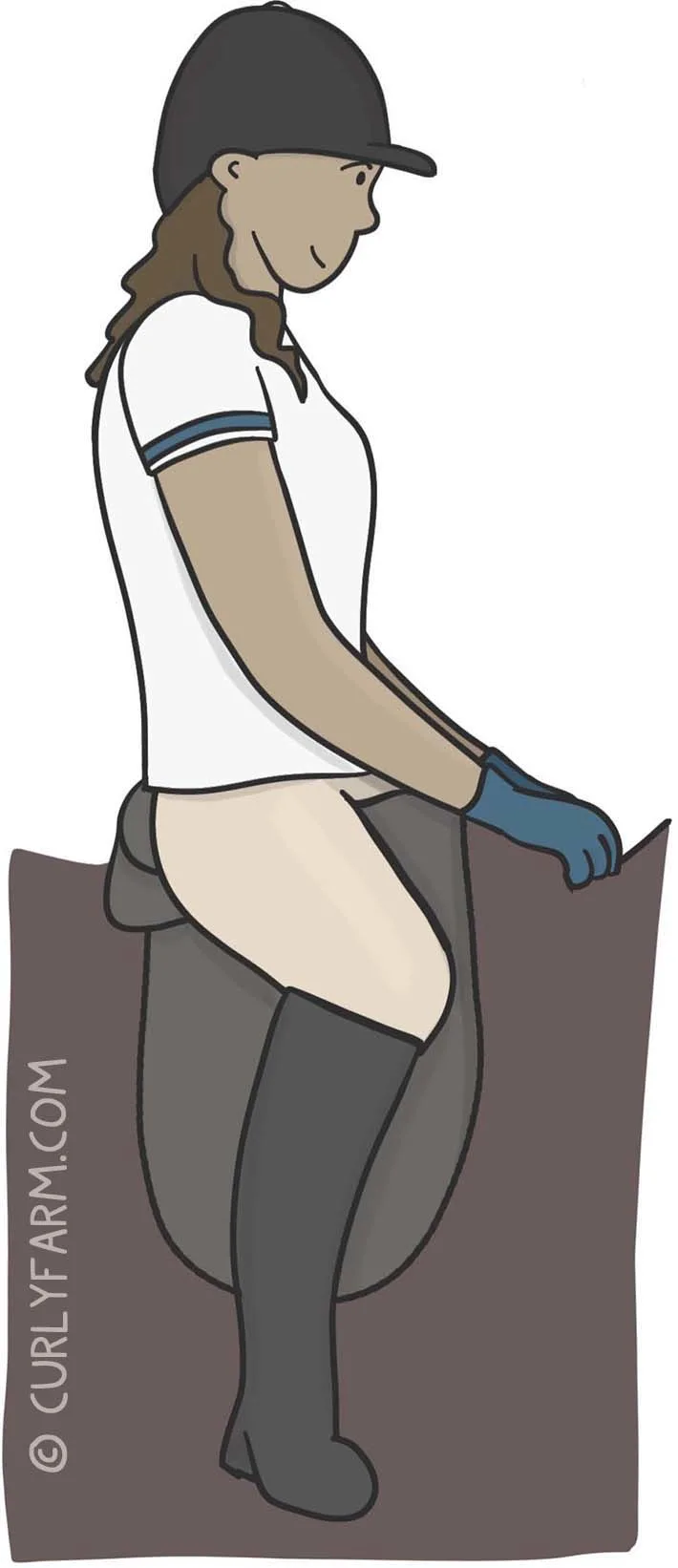Learning to sit the trot is something western rider must learn, and something most dressage riders dread! It’s the most difficult gait for most horseback riders to learn to ride, but our sitting trot tips are here to help. Below you’ll find a few easy exercises I picked up during training, competing, and teaching dressage riding with our Curly Horses. Learning to sit a trot well takes time, practice, a forgiving horse, and, perhaps most importantly, an ability to connect with your horse and move with them.

The most important part of learning to relax and ride a sitting trauma is learning how to move with your horse instead of bouncing along on top of your horse’s back.
One of my best tips for the sitting trot is actually very easy to do, and typically creates an instant improvement in a riders ability to sit deep and move with their horse during a sitting trot.
This simple exercise works a bit like a good yoga pose: giving your body the opportunity to stretch into a deeper seat with more relaxed hips. To begin this sitting trot prep exercise, follow these steps:
Tips for Preparing your Body to Ride a Sitting Trot
Learning how to stretch and prepare your body for a sitting trot is one of the best ways to quickly improve your sitting trot (and instantly boost dressage scores, if that’s your thing!) Try this exercise before your next dressage riding lesson or clinic ride, if it helps improve your sitting trot there, you can repeat this exercise before your next dressage test.
Just like warming your horse up, this specific exercise helps warm your body up to ride a bold and often bouncy dressage sitting trot without losing your seat or looking unbalanced. With your hips a little wider and a bit softer, you can absorb more of the concussion from your horse’s gait through your hips and lower back, moving more smoothly together as to bodies joined by a saddle rather than entities moving in slightly different orbits.
How to stretch and prepare to sit a sitting trot in five steps:
Before starting: Halt your horse in a safe location. Have a handler hold your horse’s bridle if you aren’t sure your horse will stay put. This exercise can destabilize your seat in the saddle, so do your best to ensure that your horse will not move unexpectedly. If you are a new rider or on a horse prone to move unexpectedly, do this exercise while you hold onto a bit of mane or grip the front of your saddle while someone else holds your horse from the ground.

How to stretch and prepare to sit a sitting trot in five steps
Lift Your Knees

Sitting upright and centered in the saddle and looking straight ahead, lift your legs up out of your stirrups and raise them until your thighs are parallel to the ground- projecting straight forward from the pelvis. Your knees will be up near the pommel of your saddle.
Rotate Hips Outward

In the next step of this sitting trot warmup stretch, spread your knees apart by rotating your hips outward. Try to keep your thighs parallel to the ground, but extend your knees out and away from your saddle as far as you are comfortably able.
Drop Knees

Now, drop your knees down, extend your thigh downward, and allow your legs to naturally close back around your saddle softly.
Stretch Thighs Back

Press your leg backward, stretching it just a bit behind the typical point where it would rest on your saddle and feel your now more open hips and seat bones settle.
Relax into Position

Take a deep breath and let your body weight drop into your now more open hips, return your leg to the natural resting point and place your feet back in your stirrups. You should be able to feel yourself slide more deeply into your saddle while still sitting upright and looking straight ahead.
Ride Forward into a Sitting Trot

Gather your reins and ride forward. Transition up into a sitting trot and try holding this soft, deep seat as your horse trots forward. Most horses respond to this deeper seat with a bigger but more easily sat trot which, as a bonus, should land you improve scores in your next dressage test.

More Sitting Trot Tips
Don’t force your heels down in sitting trot, but make your ankles as loose and relaxed as possible. Loose ankles can absorb a lot of the shock before it ever gets to your body. In sitting trot, you don’t want a lot of weight in your stirrups, but you DO want to be using them enough that your loose, relaxed ankles can absorb some of the impact.
Use your abdominal muscles to absorb more of the impact. Make sure your shoulders are back and your chest is open, try holding a very slight ab crunch when sitting.
Concentrate on allowing the outer muscles in your thigh to stretch and wrap around the horse.
One of the classical exercises to teach you to move with your horse at sitting trot is to put your horse in a trot, then recline back to a 45 degree angle, maintaining the trot. (careful the first time to see how your horse responds- some horses may respond unpredictably to this.) When you’re leaned back, you feel every movement of the trot. While this can be bumpy, it invites a rider’s body to move with a horse rather than against it. When you feel like you’ve got the movement down, sit up slowly (with your abs) trying to maintain that movement. When you lose the rhythm, lean back again.
The USDF recently published a resource that has additional tips on how to master this often difficult-to ride well horse gait.


Wally waifer
Friday 1st of July 2022
Thank you this really helped a lot!